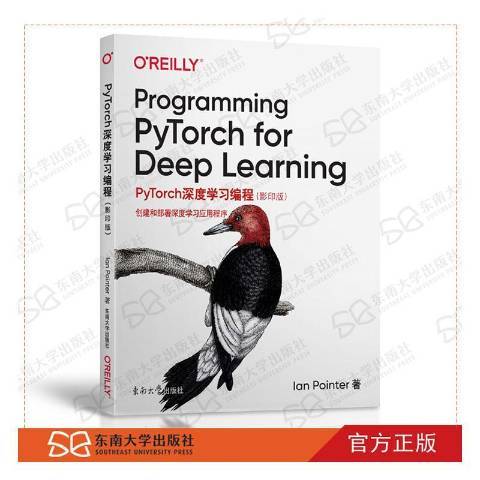《PyTorch深度學習編程》是2020年東南大學出版社出版的圖書。
基本介紹
- 中文名:PyTorch深度學習編程
- 作者:[美] 伊恩·波特
- 類別:機器學習
- 出版社:東南大學出版社
- 出版時間:2020年6月
- 開本:16 開
- 裝幀:平裝
- ISBN:9787564188795

《PyTorch深度學習編程》是2020年東南大學出版社出版的圖書。
《PyTorch編程技術與深度學習》是清華大學出版社於2022年出版的書籍,作者是袁梅宇。內容簡介 《PyTorch編程技術與深度學習》講述深度學習的基本原理,使用PyTorch展示涉及的深度學習算法。通過理論講解和編程操作,使讀者了解並掌握深度學習的...
《Python深度學習:邏輯、算法與編程實戰》是2020年機械工業出版社出版的圖書,作者是何福貴。內容簡介 機器學習是人工智慧領域一個極其重要的研究方向,而深度學習則是機器學習中一個非常接近AI的分支,其思路在於建立進行分析學習的神經網路...
《pytorch深度學習入門與實戰》是2020年中國鐵道出版社出版的圖書。《PyTorch深度學習入門與實戰》書中以案例形式詳細介紹了PyTorch的各種實戰套用。詳解PyTorch框架分散式計算、CUDA擴展等高級使用技巧 涵蓋圖像分類、文本處理、物體定位、自動...
《PyTorch深度學習》是2020年1月人民郵電出版社出版的圖書,作者是[印度]毗濕奴·布拉馬尼亞(Vishnu Subramanian)。內容簡介 PyTorch是Facebook於2017年初在機器學習和科學計算工具Torch的基礎上,針對Python語言發布的一個全新的機器學習工具包...
《深度學習框架PyTorch:入門與實踐(第2版)》是電子工業出版社出版圖書,作者是王博,周藍翔,陳雲。從多維數組 Tensor 開始,循序漸進地介紹 PyTorch 各方面的基礎知識,並結合深度學習中的經典套用,帶領讀者從零開始完成幾個經典而有...
《PyTorch深度學習實戰》是2020年機械工業出版社出版的圖書,作者是謝林·托馬斯(Sherin Thomas)、蘇丹舒·帕西(Sudhanshu)。內容簡介 PyTorch是一個嶄新的、輕量級的、以Python為優先開發語言的深度學習框架。PyTorch由Facebook開發,以其...
《PyTorch深度學習實戰:從新手小白到數據科學家》由電子工業出版社於2020年8月出版,由張敏編著。本書從理論到實戰,帶讀者系統學習PyTorch.內容簡介 PyTorch作為深度學習領域逐漸崛起的新星,其易用性及Python友好性深受廣大算法愛好者的...
《深入淺出PyTorch——從模型到源碼》涉及PyTorch基礎操作組合構造複雜的深度學習模型及其這些模型在計算機視覺、自然語言處理、推薦系統、語音識別、語音合成和強化學習中的套用。內容簡介 《深入淺出PyTorch——從模型到源碼》介紹學術界和...
本書選用Facebook開源深度學習庫PyTorch作為深度學習框架,讀者可以通過實戰操作,快速創建經典卷積神經網路、循環神經網路、自編碼模型、對抗生成網路等模型。開啟海綿模式,儘可能多地學習深度學習原理知識,並有針對性地進行實際訓練,相信一定...
《PyTorch深度學習和圖神經網路卷2 開發套用》是2021年人民郵電出版社出版的圖書,作者是李金洪。內容簡介 本書通過深度學習實例,從可解釋性角度出發,闡述深度學習的原理,並將圖神經網路與深度學習結合,介紹圖神經網路的實現技術。本書...
《PyTorch深度學習入門與實戰》是2020年中國水利水電出版社出版的圖書,作者是孫玉林,余本國。本書是一本強調實用性,注重讀者實踐的PyTorch深度學習。配套原始碼檔案及售後讀者QQ群,與作者線上交流學習。內容簡介 《PyTorch 深度學習入門與...
《PyTorch深度學習簡明實戰》是清華大學出版社於2022年出版的書籍,作者是日月光華 內容簡介 本書針對深度學習及開源框架——PyTorch,採用簡明的語言進行知識的講解,注重實戰。全書分為4篇,共19章。深度學習基礎篇(第1章~第6章)包括...
本書適合深度學習初學者、PyTorch初學者、PyTorch深度學習項目開發人員學習,也可作為高等院校或高職高專學校計算機技術、人工智慧、智慧型科學與技術、數據科學與大數據技術等相關專業的教材。圖書目錄 目 錄 第1章 PyTorch 2.0—一個新...
1.1.8 使用已完成學習的 VGG 模型對手頭上的圖片進行預測 1.2 使用 PyTorch 進行深度學習的實現流程 1.3 遷移學習的編程實現 1.3.1 遷移學習 1.3.2 準備資料夾 1.3.3 準備工作 1.3.4 實現代碼的初始設定 1.3.5 創建 ...
第 1部分 PyTorch核心 第 1章 深度學習和PyTorch庫簡介 3 1.1 深度學習革命 4 1.2 PyTorch深度學習 5 1.3 為什麼用PyTorch 6 1.4 PyTorch如何支持深度學習概述 8 1.5 硬體和軟體要求 10 1.6 練習題 12 1...
《基於PyTorch的深度學習》是一本2020年出版的圖書,由中國電力出版社出版。內容簡介 學習如何在生產環境部署深度學習模型。研究多家領先公司的PyTorch用例。學習如何對圖像套用遷移學習。使用Wikipedia上訓練的一個模型套用前沿的NLP技術。使用...
本書第1章介紹深度學習的概念和目前的形勢,第2章介紹Python編程語言基礎,第3章使用Python語言計算極限、導數、級數等數學問題,第4章講解深度學習的基本原理與PyTorch框架的基本使用,第5章和第6章詳細講述經典網路結構CNN和RCNN,第7~...
《PyTorch深度學習與企業級項目實戰》是一本清華大學出版社出版的圖書,作者是宋立桓 宋立林 內容簡介 《PyTorch深度學習與企業級項目實戰》立足於具體的企業級項目開發實踐,以通俗易懂的方式詳細介紹PyTorch深度學習的基礎理論以及相關的必要...
本書同時覆蓋深度學習的方法和實踐,主要面向在校大學生、技術人員和研究人員。閱讀本書需要讀者了解基本的Python編程知識及預備知識中描述的線性代數、微分和機率等基礎知識。作者簡介 阿斯頓.張(Aston Zhang),Amazon資歷深厚的研究員,...
《PyTorch深度學習和圖神經網路卷1 基礎知識》是2021年人民郵電出版社出版的圖書,作者是李金洪。內容簡介 本書從基礎知識開始,介紹深度學習與圖神經網路相關的一系列技術與實現方法,主要內容包括PyTorch的使用、神經網路的原理、神經網路的...
這些任務都是為幫助讀者積累實踐經驗,以便能在實際開發中靈活運用深度學習技術精挑細選出來的。讀者只要親自動手,依次對各種任務進行編程實踐,並徹底理解其中的原理,就一定能逐步掌握複雜深度學習的套用方法。《PyTorch深度學習模型開發實戰...
《邊做邊學深度強化學習:PyTorch程式設計實踐》是2020年機械工業出版社出版的圖書。內容簡介 Pytorch是基於python且具備強大GPU加速的張量和動態神經網路,更是Python中優先的深度學習框架,它使用強大的 GPU 能力,提供極高的靈活性和速度。
1.3.2 深度網路架構 7 1.3.3 GPU 11 1.4 深度學習為什麼如此成功 11 1.4.1 特徵學習 11 1.4.2 遷移學習 12 1.5 小結 13 1.6 參考文獻 14 第 2章 PyTorch簡介 15 2.1 PyTorch安裝 15 2.2 初識PyTorch...
《碼農的零門檻AI課:基於fastai與PyTorch的深度學習》深入淺出地介紹了深度學習的概念,並為讀者提供了掌握深度學習的詳細指導。 本書的目標讀者是對深度學習感興趣的廣大程式設計師,只要你有一些編程基礎,即可通過這本書輕鬆上手深度學習。
本書同時覆蓋深度學習的方法和實踐,主要面向在校大學生、技術人員和研究人員。閱讀本書需要讀者了解基本的Python編程知識及預備知識中描述的線性代數、微分和機率等基礎知識。作者簡介 阿斯頓.張(Aston Zhang),亞馬遜資深科學家,美國...
1.3.2 深度網路架構 7 1.3.3 GPU 11 1.4 深度學習為什麼如此成功 11 1.4.1 特徵學習(representation learning) 11 1.4.2 遷移學習(transfer learning) 12 1.5 小結 13 參考文獻 14 第 2章 PyTorch簡介 15...
《深度學習理論與實戰——PyTorch案例詳解》是2021年清華大學出版社出版圖書,作者是陳亦新。內容簡介 本書介紹內容包括支持向量機、線性回歸、決策樹、遺傳算法、深度神經網路(VGG、GooleLeNet、Resnet、MobileNet、EfficientNet)、循環神經...
5 PyTorch中常用的工具 5.1 數據處理 5.2 計算機視覺工具包:torchvision 5.3 可視化工具 5.3.1 Tensorboard 5.3.2 visdom 5.4 使用GPU加速:cuda 5.5 持久化 6 PyTorch實戰指南 6.1 編程實戰:貓和狗二分類 6.1.1 比賽...
